Shoot 'em ups are a sub-genre of action games. There is no consensus as to which design elements compose a shoot 'em up; some restrict the definition to games featuring spacecraft and certain types of character movement, while others allow a broader definition including characters on foot and a variety of perspectives.
Racing games are a video game genre in which the player participates in a racing competition. They may be based on anything from real-world racing leagues to fantastical settings. They are distributed along a spectrum between more realistic racing simulations and more fantastical arcade-style racing games. Kart racing games emerged in the 1990s as a popular sub-genre of the latter. Racing games may also fall under the category of sports video games.

Time Crisis II is a 1997 light gun arcade video game developed and published by Namco. It is the second installment in the Time Crisis series. The game incorporates the same mechanics of its predecessor, with some minor changes, but with the addition of co-operative two-player gaming. The game's story focuses on the efforts of two secret agents, Keith Martin and Robert Baxter, as they attempt to thwart the efforts of a industry mogul's plan for world dominance.

1943: The Battle of Midway is a 1987 vertically scrolling shooter arcade video game developed and published by Capcom.

Street Fighter Alpha 3, released as Street Fighter Zero 3 in Japan, Asia, South America, and Oceania, is a 2D fighting game originally released by Capcom for the arcade in 1998. It is the third and final installment in the Street Fighter Alpha sub-series, which serves as a sequel to Street Fighter Alpha 2, and ran on the same CP System II hardware as previous Alpha games. The game was produced after the Street Fighter III sub-series has started, being released after 2nd Impact, but before 3rd Strike. Alpha 3 further expanded the playable fighter roster from Street Fighter Alpha 2 and added new features such as selectable fighting styles called "isms".
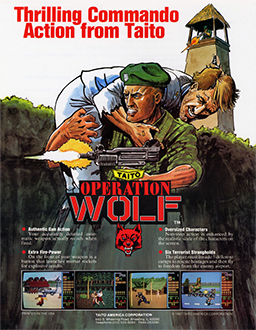
Operation Wolf is a light gun shooter arcade game developed by Taito and released in 1987. It was ported to many home systems.

Jackal, also distributed under the title of Top Gunner, is an overhead run and gun video game by Konami released for arcades in 1986. The player must maneuver an armed jeep in order to rescue prisoners of war (POWs) trapped in enemy territory.
Point Blank, known as Gun Bullet, or Gunvari in Japan, is a series of light gun shooter games developed by Namco for the arcade, PlayStation and Nintendo DS; the trilogy was first released in arcade in 1994 and was later ported onto the PlayStation. Point Blank DS was released in 2006 for the Nintendo DS featuring 40 challenges from the original series.

Time Crisis is a first-person on-rails light gun shooter series of arcade video games by Namco, introduced in 1995. It is focused on the exploits of a fictional international intelligence agency who assigns its best agents to deal with a major threat by a hostile organisation, which has ranged from criminals, terrorists and hostile military outfits, and mostly take place within fictional locations across the world. The arcade series differed from other light gun shooters of its time by incorporating unique mechanics, including the ability to duck into cover to dodge attacks and reload the player's weapon, and forcing players to complete battles in each level within an allotted amount of time.

Zero Gunner 2 is a 3D multidirectional shooter developed by Psikyo as a sequel to Zero Gunner, the original arcade game. It was released for the Dreamcast in Japan in 2001.

Sonic Blast Man is a video game franchise by Taito starring the titular superhero, Sonic Blastman. The game originally started as an arcade video game in 1990, but eventually made its way to the SNES in 1992, with much different gameplay. Both versions received a sequel.
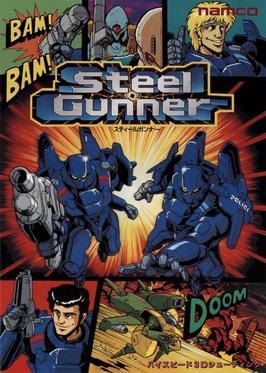
Steel Gunner is a 1990 first-person shooter arcade game developed and published by Namco. Players take control of Garcia and Cliff, a duo of police officers that are part of the Neo Arc police force, as they must use their powerful Gargoyle mecha suits to destroy the STURM terrorist organization, who have taken captive scientists Dr. Ryan and Dr. Ellis to create a world-ending superweapon. Gameplay revolves around using a crosshair to shoot down enemies and avoid harming civilians. It runs on the Namco System 2 Plus arcade hardware.
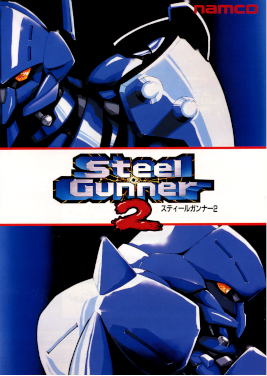
Steel Gunner 2 is a 1992 first-person shooter game developed and released by Namco for arcades. It is the sequel to Steel Gunner, which had been released in 1990. It was also sold as a conversion kit for Taito's Operation Thunderbolt (1988).
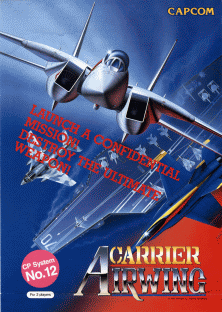
Carrier Air Wing, released in Japan as U.S. Navy, is a 1990 side-scrolling shooting game released for the CP System arcade hardware by Capcom. It is the spiritual successor to U.N. Squadron, which was released in the previous year. As with the original, players chose any one of three different jet fighters and battle their way through ten enemy-packed stages. Other ideas carried over from U.N. Squadron include the shop, which allows players to buy weapon and shield upgrades for their jet fighter between stages, and the energy bar, which is replaced by a "fuel bar" which starts full at the start of each stage and decreases as time passes with some fuel lost each time the plane is damaged. The game has two different endings, depending on whether the game is finished with only one coin or not. A version for the Capcom Power System Changer was planned and previewed but never released.
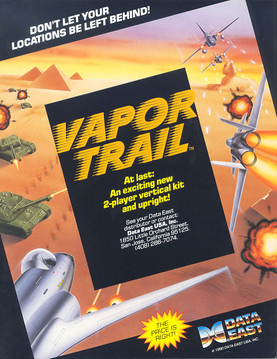
Vapor Trail: Hyper Offense Formation, known in Japan as Kuuga – Operation Code Vapor Trail and usually simply referred to as Vapor Trail, is a 1989 shoot 'em up arcade game developed and published by Data East. Vapor Trail was followed by Rohga: Armor Force and Skull Fang.
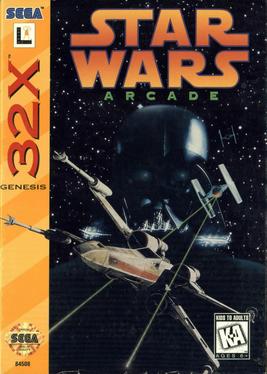
Star Wars is a 1993 arcade game developed by Sega and based on the original Star Wars trilogy. Combining elements of A New Hope and Return of the Jedi, the game has players pilot a Rebel starship and battle against the forces of the Empire. Sega developed Star Wars for their Model 1 system, the same arcade hardware that powered Virtua Fighter and Virtua Racing. Like those two titles, the graphics in Star Wars are rendered entirely using polygons. The game was given a home port under the name Star Wars Arcade, as an exclusive for the Sega 32X's launch in 1994.
Light-gun shooter, also called light-gun game or simply gun game, is a shooter video game genre in which the primary design element is to simulate a shooting gallery by having the player aiming and discharging a gun-shaped controller at a screen. Light-gun shooters revolve around the protagonist shooting virtual targets, either antagonists or inanimate objects, and generally feature action or horror themes and some may employ a humorous, parodic treatment of these conventions. These games typically feature "on-rails" movement, which gives the player control only over aiming; the protagonist's other movements are determined by the game. Games featuring this device are sometimes termed "rail shooters", though this term is also applied to games of other genres in which "on-rails" movement is a feature. Some, particularly later, games give the player greater control over movement and in still others the protagonist does not move at all. On home computer conversions of light-gun shooters, mouse has been often an optional or non-optional replacement for a light gun.
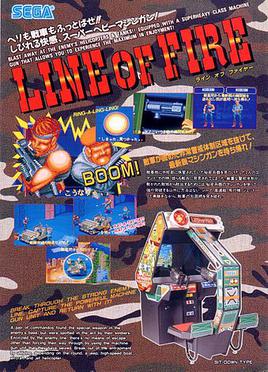
Line of Fire is a first-person light gun shooter game developed by Sega and released for arcades in 1989. It was released with two arcade cabinet versions, a standard upright and a sit-down cockpit, both featuring two positional guns. The cockpit design allows the player(s) to sit down while playing the game, while having two-handed machine guns, controlled by a potentiometer-controlled gun alignment software system. The game follows a two-man commando unit as they try to escape from a terrorist facility after seizing a prototype weapon.

Gunblade NY is a light gun rail shooter developed by Sega for the Model 2 arcade machine and was released in 1995 in North America and 1996 in Japan. The game was re-released alongside its sequel, L.A. Machineguns: Rage of the Machines for the Wii in 2010 as part of the Sega Arcade Hits Pack.

An arcade game or coin-op game is a coin-operated entertainment machine typically installed in public businesses such as restaurants, bars and amusement arcades. Most arcade games are presented as primarily games of skill and include arcade video games, pinball machines, electro-mechanical games, redemption games or merchandisers.
















